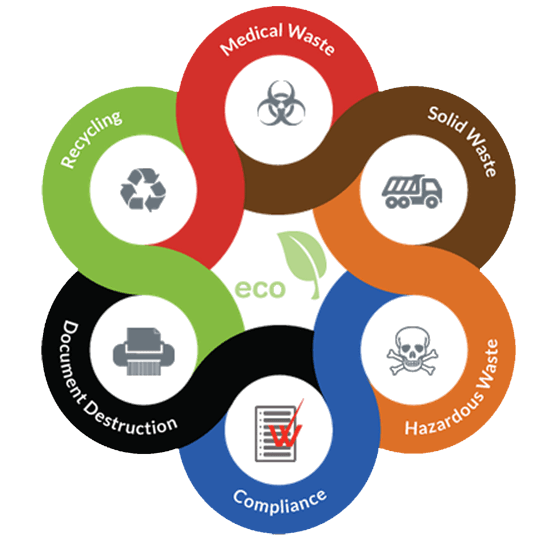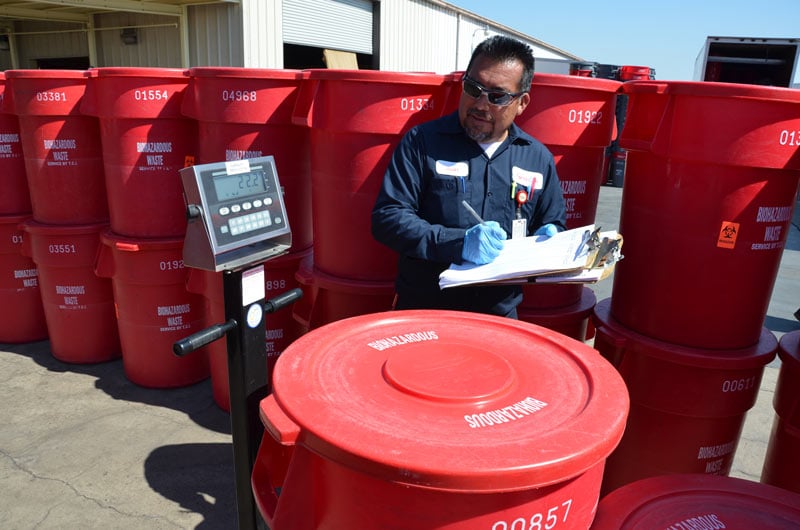Best Practices for Medical Waste Monitoring
Medical waste administration is a crucial element of health care centers' procedures to ensure the security of individuals, team, and the environment. Carrying out ideal practices in clinical waste monitoring is crucial to minimize the threats associated with hazardous waste.

Partition and Classification
In the area of medical waste administration, appropriate partition and categorization are vital techniques for ensuring the secure and reliable disposal of healthcare-related materials. Clinical waste is generated from various resources, consisting of health centers, centers, labs, and various other health care facilities. It is composed of a large range of items, such as needles, syringes, plasters, gloves, and pharmaceutical waste.
Partition entails the systematic separation of different kinds of clinical waste based on their qualities and prospective risks. This process helps to protect against cross-contamination and guarantees that each sort of waste is dealt with appropriately. Sharps waste, such as needles and blades, must be placed in puncture-resistant containers to avoid injuries and the spread of transmittable diseases. Infectious waste, such as blood-soaked bandages or cultures, need to be set apart and treated independently to lessen the risk of spreading out pathogens.
Categorization is the process of identifying clinical waste right into various classifications based upon its prospective hazards. These classifications might consist of infectious waste, dangerous waste, pharmaceutical waste, and basic waste. By classifying waste, healthcare centers can establish the appropriate disposal methods and make sure compliance with regional guidelines and standards.
Appropriate partition and classification of medical waste not just shield the health and wellness and safety and security of healthcare workers and the public yet also add to the overall efficiency and effectiveness of waste monitoring. It reduces the danger of mishaps, decreases ecological influences, and promotes liable garbage disposal practices.
Proper Storage and Classifying
To guarantee the safe and effective disposal of clinical waste, healthcare centers should stick to appropriate storage space and labeling practices. WasteX Medical Waste Disposal. Correct storage space and labeling play a crucial function in preserving the integrity of clinical waste monitoring systems and securing the health and wellness and safety and security of healthcare employees, people, and the basic public
When it involves storage, it is necessary to have designated locations particularly created for different kinds of clinical waste. These locations ought to be secure, well-ventilated, and outfitted with ideal containers that satisfy regulative standards (medical waste disposal). Segregation and categorization of waste ought to likewise be taken right into consideration to prevent cross-contamination and potential threats

Normal monitoring and evaluation of storage locations and containers are necessary to recognize any kind of concerns or infractions. Personnel must be educated on appropriate storage and labeling practices, stressing the relevance of conformity with protocols and laws.
Safe Transport and Handling
Making sure the safe and appropriate transport and handling of clinical waste is vital for preserving the integrity of waste monitoring systems and guarding the wellness and safety and security of all entailed. Medical waste, that includes items infected with contagious materials, drugs, and various other harmful substances, must be carried in a manner that avoids leaks, spills, and prospective contamination.
To accomplish secure transport and handling, a number of finest methods need to be followed. First, it is important to utilize leak-proof and puncture-resistant containers that are specifically created for medical waste. These containers should be correctly secured and identified to stop any type of unintentional exposure or mishandling. In addition, waste should be segregated based upon its nature and kind to stop cross-contamination.
During transportation, it is necessary to make certain that waste containers are firmly attached and stored in a stable way. Vehicles made use of for transferring medical waste ought to be furnished with ideal security features, such as spill control systems, to reduce the danger of any kind of spills or leakages. Vehicle drivers should get training on proper handling and emergency situation action treatments to properly attend to any unforeseen events.
In addition, the transportation and handling of medical waste must adhere to all appropriate regulations and standards established forth by regional, state, and government authorities. WasteX Medical Waste Disposal. medical waste disposal service. Routine evaluations and audits need to be conducted to examine compliance and determine any kind of areas for improvement
Conformity With Regulatory Standards
Maintaining conformity with governing guidelines is vital for efficient medical waste administration. These standards are implemented to safeguard public health and wellness and the setting by making certain that clinical waste is appropriately managed, dealt with, and disposed of. Compliance with regulatory standards assists to stop the spread of contagious conditions, lessen possible dangers, and decrease the total impact of medical waste on the atmosphere.
To achieve compliance, healthcare facilities must stay educated concerning the specific policies governing clinical waste monitoring in their jurisdiction. These guidelines might differ from country to country, and even within various states or regions. It is vital for health care facilities to have a detailed understanding of these guidelines and to implement proper strategies and protocols to make sure conformity.
One key aspect of compliance is the correct partition and labeling of various types of medical waste. This consists of separating sharps from various other waste, in addition to classifying waste based upon its potential threats. Health care facilities need to also make certain that clinical waste is saved in appropriate containers and that these containers are properly classified and sealed.
Additionally, compliance with governing standards calls for medical care centers to develop correct training and education and learning programs for staff participants included in medical waste administration. This includes offering training on waste segregation, handling, and disposal procedures, along with the proper usage of personal protective equipment.
Regular tracking and audits are likewise important to guarantee continuous compliance with regulative guidelines. This includes performing routine examinations of waste storage areas, recording waste administration treatments, and maintaining records of garbage disposal.
Reliable Disposal Methods
Health care centers have to employ reliable disposal techniques for proper monitoring of clinical waste. Improper disposal of clinical waste can position serious wellness and ecological threats. There are numerous methods that can be utilized to efficiently get rid of medical waste, ensuring the security of medical care employees, clients, and the general public.
One typically made use of technique is incineration. Burners can securely melt medical waste at high temperature levels, lowering the quantity and damaging any type of potentially hazardous virus. Incineration can be pricey and might launch harmful toxins right into the air if not effectively regulated.
One more approach is autoclaving, which entails subjecting the waste to high-pressure vapor. This process eliminates microorganisms, infections, and other bacteria, providing the waste secure for disposal in regular waste streams. Autoclaving is a efficient and eco pleasant technique, but it requires customized equipment and skilled employees.
Chemical disinfection is also made use of in some situations, where liquid chemicals are used to the waste to sanitize it. This method is much less generally used as a result of concerns regarding the efficiency of chemical disinfection and the possibility for chemical deposits to contaminate the environment.
Along with these techniques, health care facilities should likewise apply appropriate segregation, product packaging, and labeling of clinical here are the findings waste to guarantee its safe handling and disposal. Regular training and education and learning of personnel on appropriate waste management practices are crucial to maintaining efficient disposal techniques.
Conclusion
Finally, executing finest techniques for clinical waste management is vital for making certain the security of medical care employees, individuals, and the atmosphere. By properly categorizing and segregating waste, keeping and identifying it properly, ensuring risk-free transportation and handling, following regulatory standards, and utilizing efficient disposal methods, health care facilities can effectively take care of and minimize the dangers related to medical waste. It is important for health care organizations to adhere and focus on to these finest methods to keep a lasting and risk-free medical care environment.
Medical waste management is a crucial element of health care centers' operations to make sure the security of individuals, personnel, and the setting. Carrying out ideal techniques in medical waste management is important to lessen the threats connected with unsafe waste. These classifications may consist of infectious waste, unsafe waste, pharmaceutical waste, and general waste.In verdict, carrying out ideal techniques for medical waste management is essential for ensuring the safety and security of medical care employees, clients, and the environment. By correctly categorizing and setting apart waste, storing and classifying it appropriately, guaranteeing safe transportation and handling, conforming with governing guidelines, and utilizing efficient disposal techniques, healthcare facilities can successfully handle and decrease the dangers linked with medical waste.